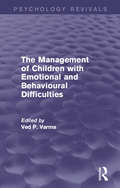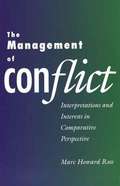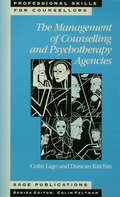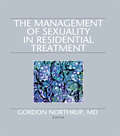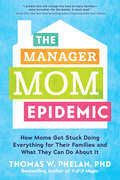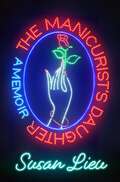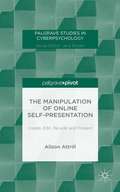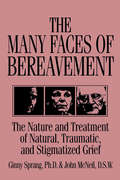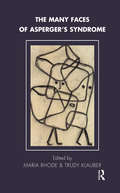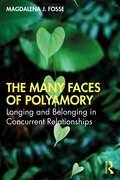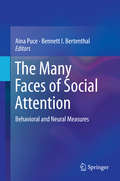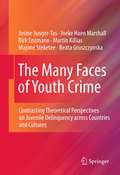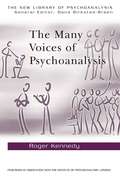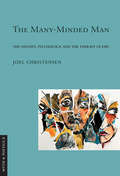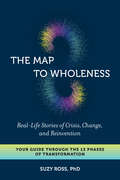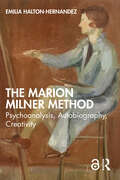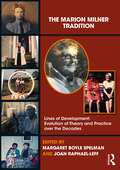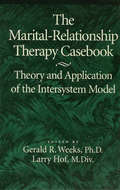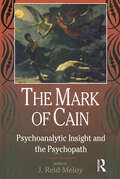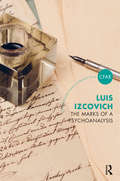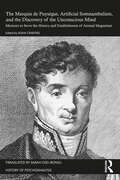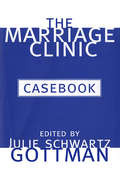- Table View
- List View
The Management of Children with Emotional and Behavioural Difficulties (Psychology Revivals)
by Ved P. VarmaThe management of children with emotional and behavioural difficulties has always been a source of worry and concern to those who have to deal with them. Many such children are unpredictable, sometimes embarrassing, and can often make us feel helpless. We need to know more about them, and why they think, feel, and behave as they do. Originally published in 1990, the contributors to this volume bring a wide-ranging professional, practical approach to the problem, looking at it from the perspectives of psychiatry, psychology, psychotherapy, education, and social work. They underline the fact that such behaviour cannot be assessed in isolation from the context in which it occurs, and go beyond a mere description of maladjusted children to ask, ‘Maladjusted to what? And under what conditions?’ The social and family context is continually borne in mind. The book will still be of great interest to psychologists, psychiatrists, psychotherapists, teachers and social workers, as well as to students in those disciplines, who will find it an invaluable source to help them in their first encounters with child patients, clients and pupils.
The Management of Conflict: Interpretations and Interests in Comparative Perspective
by Marc Howard RossTopics include: Political anthropology, Conflict management in cross-cultural studies, and Ethnopsychology.
The Management of Counselling and Psychotherapy Agencies (Professional Skills for Counsellors Series)
by Mr Colin Lago Mr Duncan KitchinThe authors of this book provide clear guidelines on the many aspects of knowledge, skill and management expertise increasingly required by all counselling services. Due consideration and detailed advice is given on a broad range of essential issues, from setting up a counselling service to customer relations and quality control. Topics examined include: implications of funding; budgeting; staffing; location and furnishing of premises; daily working routines; how to ensure a competent, professional, safe and ethical working practice; and the sheer complexities of being a manager of therapists.
The Management of Sexuality in Residential Treatment
by Gordon NorthrupHere are practical ideas and help for dealing with problems of sexuality in residential treatment settings. On a day-to-day level, difficulties can arise from the need for child care workers to maintain caring and personal relationships with children in the face of the children’s and their own sexuality. Children themselves also may have difficulties in properly expressing their sexuality. The Management of Sexuality in Residential Treatment examines a broad range of problems that often occur and describes several treatment programs and strategies for coping with incidents of abuse or alleged abuse.Chapters in the book address issues pertinent for professionals working with children in residential treatment. Authors cover topics such as: residents’needs for love versus sexuality the impact of sexually stimulating materials erotic countertransference in a residential treatment center survey of minor sex problems in the milieu and how to respond to them personal relationships between residents and staffThe book also describes two treatment programs for abused or abusing children. The first is an eight week multimodal therapeutic program for adolescent girls who have been sexually abused, the other a course for sexually abusive boys that includes counseling, sex education, and journal writing. The Management of Sexuality in Residential Treatment is a valuable resource for the staff of residential treatment centers, group homes, residential schools, and hospital pediatric units who wish to understand how to deal more effectively with issues of sexuality and the children for whom they care.
The Manager Mom Epidemic: How Moms Got Stuck Doing Everything for Their Families and What They Can Do About It
by Thomas PhelanAre you a mom who does it all? This is the book for you.It's impossible to deny—most moms continue to do way more household work and childcare than most dads. Working full time, raising kids, cooking dinner, making sure every appointment and activity is lined up and that everyone gets there on time... no wonder you're tired! But despite all the books and articles lamenting the crushing mental load and emotional labor women bear for their families, no one has come up with a plan to actually make things change. Until now.The Manager Mom Epidemic is the first book that not only acknowledges the fact that moms are burning out, but shows you how to transfer responsibility for daily tasks from yourself to your partner and also (gasp!) your kids. Clinical psychologist and child discipline expert Thomas W. Phelan, PhD explains how we got into this mess in the first place, and how we can get out of it through a calm, systematic approach to teaching our families how to take initiative and contribute in meaningful ways. Dr. Phelan walks you through real-life situations and shows you how to step back from the things that are dragging you down. For example: Your Maternal Identity—the things you tell yourself you have to do in order to be a "good" mom The oppressive trap of chronic supervision Our society's curious underestimation of children's capabilities How to eliminate primary childcare with tweens and teens How to manager resistant or traditionalist dadsRealistic and simple enough to implement in your home right away, The Manager Mom Epidemic provides a roadmap for you to take your life back and proves that the happiest families share the work and the fun equally.
The Manicurist's Daughter: A Memoir
by Susan LieuAn emotionally raw memoir about the crumbling of the American Dream and a daughter of refugees who searches for answers after her mother dies during plastic surgery.Susan Lieu has long been searching for answers. About her family’s past and about her own future. Refugees from the Vietnam War, Susan’s family escaped to California in the 1980s after five failed attempts. Upon arrival, Susan’s mother was their savvy, charismatic North Star, setting up two successful nail salons and orchestrating every success—until Susan was eleven. That year, her mother died from a botched tummy tuck. After the funeral, no one was ever allowed to talk about her or what had happened.For the next twenty years, Susan navigated a series of cascading questions alone—why did the most perfect person in her life want to change her body? Why would no one tell her about her mother’s life in Vietnam? And how did this surgeon, who preyed on Vietnamese immigrants, go on operating after her mother’s death? Sifting through depositions, tracking down the surgeon’s family, and enlisting the help of spirit channelers, Susan uncovers the painful truth of her mother, herself, and the impossible ideal of beauty.The Manicurist’s Daughter is much more than a memoir about grief, trauma, and body image. It is a story of fierce determination, strength in shared culture, and finding your place in the world.
The Manipulation of Online Self-Presentation: Create, Edit, Re-edit and Present
by Alison AttrillThis book explores psychological theories around the ways in which people present themselves online. The role of dispositional and situational factors along with the motivations that drive self-presentation across diverse Internet arenas are considered.
The Manipulators: Personality and Politics in Multiple Perspectives (Psychology Revivals)
by Allan W. LernerOriginally published in 1990, this volume had two purposes. One was to shed some light on the impact that manipulativeness has on modern institutional processes. The other was to illustrate the importance of attempting militantly interdisciplinary work on themes that run through a variety of social sciences and related disciplines, as a way of breaking down excessively stifling disciplinary barriers. Manipulativeness is a connotation-laden notion with shifting meanings across the variety of action contexts, levels of analysis, and disciplinary orientations. It absorbs the idea of strategic-mindedness, rule exploitation, situational advantage seeking, tampering with structure and context, and control of the action climate. In a way, it is a very contemporary interpretation of the theme of power, melding images of control with the experience of pervasive social ambiguity.
The Manor House
by Jane Holland'I absolutely love this book from start to finish...a really atmospheric read, and brilliant characters.' NetGalley Reader, *****1963. When Eleanor meets famous young poet, Lyndon Chance, he offers a way to flee her abusive father. In return, she must pretend to be Lyndon's wife. He takes her home to a Tudor manor on the Camel Estuary in Cornwall, where she finds herself in the middle of a feud between Lyndon and his twin brother, Oliver. It's soon clear that the old house hides many dark secrets. But could they be a threat to Eleanor?Now. Taylor has come to idyllic Cornwall to research for her Master's thesis, combining her love for conservation with a personal interest in Chance's poetry. Haunted by her own tragic past, Taylor finds Chance's notoriety fascinating. If only the poet's grandson, Julius, wasn't so determined to thwart her attempts to uncover his family secrets. As Eleanor realises she's out of her depth at Estuary House, drawn to Lyndon like a moth to a flame, Taylor and Julius must fight their own attraction - but could shadows from the past tear them all apart?A stunning and richly evocative timeslip, perfect for fans of Lucinda Riley, Santa Montefiore and Kate Morton.
The Manor House
by Jane Holland'I absolutely love this book from start to finish...a really atmospheric read, and brilliant characters.' NetGalley Reader, *****1963. When Eleanor meets famous young poet, Lyndon Chance, he offers a way to flee her abusive father. In return, she must pretend to be Lyndon's wife. He takes her home to a Tudor manor on the Camel Estuary in Cornwall, where she finds herself in the middle of a feud between Lyndon and his twin brother, Oliver. It's soon clear that the old house hides many dark secrets. But could they be a threat to Eleanor?Now. Taylor has come to idyllic Cornwall to research for her Master's thesis, combining her love for conservation with a personal interest in Chance's poetry. Haunted by her own tragic past, Taylor finds Chance's notoriety fascinating. If only the poet's grandson, Julius, wasn't so determined to thwart her attempts to uncover his family secrets. As Eleanor realises she's out of her depth at Estuary House, drawn to Lyndon like a moth to a flame, Taylor and Julius must fight their own attraction - but could shadows from the past tear them all apart?A stunning and richly evocative timeslip, perfect for fans of Lucinda Riley, Santa Montefiore and Kate Morton.
The Many Faces Of Bereavement: The Nature And Treatment Of Natural Traumatic And Stigmatized Grief
by Ginny Sprang John McNeilFirst published in 1995. Routledge is an imprint of Taylor & Francis, an informa company.
The Many Faces of Asperger's Syndrome (Tavistock Clinic Series)
by Maria Rhode Trudy KlauberThis is the first book on the psychoanalytic treatment of children, young people and adults with Asperger’s syndrome. It includes multidisciplinary contributions on psychiatric perspectives and psychological theories of the condition. There is an overview of relevant psychoanalytic theory, and chapters on Asperger’s original paper, on firstperson accounts, on assessment and on care in the community. Clinical case histories of children, young people and the first published account of work with adults provide the possibility of using psychoanalytic work as a means of diagnostically differentiating between sub-groups, as well as providing a detailed insight into the emotional experience of people with Asperger’s syndrome.
The Many Faces of Polyamory: Longing and Belonging in Concurrent Relationships
by Magdalena J. FosseThe Many Faces of Polyamory: Longing and Belonging in Concurrent Relationships provides new perspectives on polyamory and the longing to belong in the relatively uncharted territory of nonnormative relationships. This volume offers a valuable and compelling account on how to approach polyamorous relationships from the clinical perspective. While there is no uniform answer, Dr. Fosse’s compassionate and discerning approach that combines relative neutrality, an open-minded embrace of nontraditional lifestyle choices, and skilful attention to countertransference dynamics is likely to be inspiring. Dr. Fosse exposes the dynamics of love, sex, jealousy, and compersion as they play out in lives of those interested in polyamory, and more broadly, consensual nonmonogamy. Her focus is on relationships worth having. With its nuanced clinical focus, The Many Faces of Polyamory will be an essential resource for psychotherapists, educators, students, and anyone inside and outside of the mental health field drawn to the intricacies of sexuality, intimacy, and how they are intertwined with relational satisfaction
The Many Faces of Social Attention
by Aina Puce Bennett I. Bertenthalsocial neuroscience, social psychology, developmental, psychology, social cognition, vision research and clinical psychology.
The Many Faces of Youth Crime
by Josine Junger-Tas Martin Killias Ineke Haen Marshall Beata Gruszczynska Majone Steketee Dirk EnzmannThis book presents the first comprehensive analysis of the second International Self-Report Delinquency study (ISRD-2). An earlier volume, Juvenile Delinquency in Europe and Beyond (Springer, 2010) focused mainly on the findings with regard to delinquency, victimization and substance use in each of the individual participating ISRD-2 countries. The Many Faces of Youth Crime is based on analysis of the merged data set and has a number of unique features: The analyses are based on an unusually large number of respondents (about 67,000 7th, 8th and 9th graders) collected by researchers from 31 countries; It includes reports on the characteristics, experiences and behaviour of first and second generation migrant youth from a variety of cultures; It is one of the first large-scale international studies asking 12-16 year olds about their victimization experiences (bullying, assault, robbery, theft); It describes both intriguing differences between young people from different countries and country clusters in the nature and extent of delinquency, victimization and substance use, as well as remarkable cross-national uniformities in delinquency, victimization, and substance use patterns; A careful comparative analysis of the social responses to offending and victimization adds to our limited knowledge on this important issue; Detailed chapters on the family, school, neighbourhood, lifestyle and peers provide a rich comparative description of these institutions and their impact on delinquency; It tests a number of theoretical perspectives (social control, self-control, social disorganization, routine activities/opportunity theory) on a large international sample from a variety of national contexts; It combines a theoretical focus with a thoughtful consideration of the policy implications of the findings; An extensive discussion of the ISRD methodology of 'flexible standardization' details the challenges of comparative research. The book consists of 12 chapters, which also may be read individually by those interested in particular special topics (for instance, the last chapter should be of special interest to policy makers). The material is presented in such a way that it is accessible to more advanced students, researchers and scholars in a variety of fields, such as criminology, sociology, deviance, social work, comparative methodology, youth studies, substance use studies, and victimology.
The Many Voices of Psychoanalysis (The New Library of Psychoanalysis)
by Roger KennedyThe Many Voices of Psychoanalysis spans over thirty years of Roger Kennedy's work as a practicing psychoanalyst, providing a fascinating insight into the process of development of psychoanalytic identity. The introduction puts the papers into context, charting the development of the author’s practice and understanding of psychoanalysis and his position as part of the British Independent tradition. The intention of the chapters is to address the 'many voices' of psychoanalysis - the many roles and approaches a psychoanalyst may take, while adhering to the established ideas of psychoanalysis. The author takes into account the various influences which shape the psychoanalytic voice, drawing on literature, philosophy and sociology as well as analytic ideas. Subjects covered include: aspects of consciousness - one voice or many? handling the dual aspect of the transference bearing the unbearable - working with the abused mind the internal drama - psychoanalysis and the theatre a psychoanalyst in the family court. This book will be of use not only to practicing psychoanalysts, but also to psychoanalytic psychotherapists and other mental health workers. It will also appeal to anyone interested in the relationship between psychoanalysis and related disciplines.
The Many-Minded Man: The "Odyssey," Psychology, and the Therapy of Epic (Myth and Poetics II)
by Joel ChristensenIn The Many-Minded Man, Joel Christensen explores the content, character, and structure of the Homeric Odyssey through a modern psychological lens, focusing on how the epic both represents the workings of the human mind and provides for its audiences—both ancient and modern—a therapeutic model for coping with the exigencies of chance and fate.By reading the Odyssey as an exploration of the constitutive elements of human identity, the function of narrative in defining the self, and the interaction between the individual and their social context, The Many-Minded Man addresses enduring questions about the poem, such as the importance of Telemachus's role, why Odysseus must tell his own tale, and the epic's sudden and unexpected closure. Through these dynamics, Christensen reasons, the Odyssey not only instructs readers about how narrative shapes a sense of agency but also offers solutions for avoiding dangerous stories and destructive patterns of thought.
The Map to Wholeness: Real-Life Stories of Crisis, Change, and Reinvention--Your Guide through the 13 Phases of Transformation
by Suzy RossThe Map to Wholeness is an evidence-based guide for discovering your life's true purpose, deepening your experience of transformation, and emerging healthier and happier from the journeyWhat is my purpose? Am I on the right track? How do I create meaning in my life? The seemingly random events that comprise our lives can be understood as serving a higher purpose when examined through the proper lens; they are in fact the critical steps that comprise our hero's journey. Those who choose to travel this path will emerge completely transformed--healthier, happier, and in touch with their life's purpose. In this book, Susan Ross draws on her extensive research to create a map for those ready to embark on their most important adventure. The Map to Wholeness identifies the thirteen phases of personal transformation (symbolized as an upright infinity symbol or a figure-8). Readers will learn how to identify their unique location on the journey, deepen their experience, and avoid the common pitfalls that block progress. Each step on the path brings us closer to our inherent state of wholeness (even when they feel painful or pointless). By understanding the larger meaning of our circumstances from a bird's eye perspective, we learn to rest in faith and confidence, freed from crippling judgment and self-blame. We will live more deliberately, consciously, and joyfully, while simultaneously heightening our experiences of change.At the heart of this book are the personal journeys of three ordinary individuals who have descended into the darkness of their psyches, integrating a personal life-changing event, and emerging transformed. Readers will find their own life stories reflected in these real-life accounts.
The Marion Milner Method: Psychoanalysis, Autobiography, Creativity
by Emilia Halton-HernandezThis book traces the development of British psychoanalyst Marion Milner’s (1900–98) autobiographical acts throughout her lifetime, proposing that Milner is a thinker to whom we can turn to explore the therapeutic potentialities of autobiographical and creative self-expression. Milner’s experimentation with aesthetic, self-expressive techniques are a means to therapeutic ends, forming what Emilia Halton-Hernandez calls her "autobiographical cure." This book considers whether Milner’s work champions this site for therapeutic work over that of the relationship between patient and analyst in the psychoanalytic setting. This book brings to light a theory and practice which is latent and sometimes hidden, but which is central to understanding what drives Milner’s autobiographical work. It is by doing this work of elucidation and organisation that Halton-Hernandez finds Milner to be a thinker with a unique take on psychoanalysis, object relations theory, creativity, and autobiography, working at the interstices of each. Divided into two fascinating sections exploring Milner’s distinctive method and the legacy and influence of her work, this book will appeal to psychoanalysts, art therapists, philosophers, and art and literary researchers alike.
The Marion Milner Tradition: Lines of Development: Evolution of Theory and Practice over the Decades (The\lines Of Development Ser.)
by Margaret Boyle Spelman Joan Raphael-LeffThe Marion Milner Tradition provides a comprehensive overview of Milner’s eight-volume oeuvre for the first time, and celebrates her pioneering achievements both in psychoanalytic world and in creative and scientific disciplines such as clinical and organisational psychology, philosophy, mindfulness and spirituality, management theory, art therapy, as well as art appreciation/criticism. This volume considers Marion Blackett Milner through the prism of her innovative engagement with people, art, and human experience, as well as her extraordinary contribution as an original thinker and researcher within the Independent Group of the British Psychoanalytical Society. The co-editors’ exploratory approach to her legacy is as open as the spirit of Milnerean ‘discovery research’ in defining its distinctive features. An assembly of fifty contributors were invited to interrogate the evolution of what is becoming known as the Milner Tradition, demarcating her influence on theory and clinical practice over the many decades of her life and since her death. They draw upon their professional interviews or friendship with Marion Blackett Milner, or intimate experience of her as an analyst, supervisor, or relative. Similarly, participants in global reading groups in Australia, England, Greece, Northern Ireland, the Republic of Ireland, and South Africa recount personal responses to their own exercise in action research. The plethora of riches in this book will be of interest to both new and veteran readers of Milner’s opus, as well as students and practitioners from a variety of therapeutic and other disciplines.
The Marital-Relationship Therapy Casebook: Theory & Application Of The Intersystem Model
by Gerald Weeks Larry HofFirst published in 1994. Routledge is an imprint of Taylor & Francis, an informa company.
The Mark of Cain: Psychoanalytic Insight and the Psychopath
by J. Reid MeloyThe Mark of Cain makes available for the first time the accumulated psychoanalytic understanding of the psychopathic mind. Editor Reid Meloy, a leading authority on the psychology of the psychopath, has brought together in a single collection the most historically important psychoanalytic papers on the psychopath and delineted their continuing relevance to contemporary understanding. According to Meloy, two theoretical traditions flow into the psychoanalytic understanding of psychopathy. The first tributary focuses on the early development of the psychopath in order to illuminate how a profound alteration in self-regard leads both to a denigration of the other and to an impulsive search for gratification in the present. The second tributary seeks to locate the psychopathic miscarriage of human potentiality within analytic theories of personality structure and clinically grounded differential diagnosis. Meloy presents the major contributions associated with both of these traditions. Included within this body of literature are the original formulations of concepts that have long since become part of the psychoanalytic nomenclature: the "affectionless" juvenile offender, the diagnostic significance of "affect hunger," the behavioral consequences of "superego lacunae," the recourse to promiscuous identification in "the impostor," and the paradoxically lethal lure of "malignant narcissism." Of special interest are Meloy's historical notes to each chapter and two section introductions, the latter major essays in their own right. The explosion of empirical research on psychopathy over the past two decades masks the fact that much contemporary work in this area is grounded in the clinical formulations of leading psychoanalysts of the twentieth century. The Mark of Cain rescues this intimate understanding of the inner world of the psychopath and thereby contributes to clinical realism in the face of deception, manipulation, exploitation, and even frank dangerousness.
The Marks of a Psychoanalysis (The Centre for Freudian Analysis and Research Library (CFAR))
by Luis IzcovichIs someone radically different after an analysis? Since Freud, psychoanalysis has been questioned about what the psychoanalytic experience can change in someone's life beyond shedding light on symptoms. Drawing on literature, philosophy and a range of psychoanalytic theorists and practitioners, the author addresses the effects of psychoanalysis on the individual who has the desire and the courage to enter an analytic treatment and take it to its endpoint. The subject bears the marks of his childhood and these have repercussions on the choices that he makes in life. Do these marks determine him or does he have a choice in making his destiny? How do the transformations brought about in the transference change the subject? And does the analysis leave a distinguishing and locatable mark? The author attempts to answer these questions from a Lacanian perspective.
The Marquis de Puységur, Artificial Somnambulism, and the Discovery of the Unconscious Mind: Memoirs to Serve the History and Establishment of Animal Magnetism (The History of Psychoanalysis Series)
by Adam Crabtree Sarah Osei-BonsuThe Marquis de Puységur, Artificial Somnambulism, and the Discovery of the Unconscious Mind presents the first full English translation of a foundational text in the history of psychodynamic thinking, and provides a contextual explanation of its contemporary significance.Written by Puységur in 1784, Memoirs to Serve the History and Establishment of Animal Magnetism describes the author’s exploration and discovery of “artificial somnambulism,” a state that reveals insights into the subconscious mind. Building on the healing techniques of Franz Anton Mesmer, Puységur kept detailed notes on his practice with patients, including their names, symptoms, and follow-up information, providing a unique insight into his process. The full text of this original publication is presented here, complemented by a historical introduction and editor’s notes.The Marquis de Puységur, Artificial Somnambulism, and the Discovery of the Unconscious Mind will be of great interest to academics and scholars of psychoanalysis, psychotherapy, and the history of psychology, hypnosis, and mental health. It will also appeal to practicing clinicians.
The Marriage Clinic Casebook
by Julie Schwartz GottmanThe Marriage Clinic Casebook bridges the gap between the powerful theory behind Gottman Method Couples Therapy and the unique application of therapeutic principles to real-life cases. Covering a broad range of couples as well as a variety of relational problems, this casebook is a resource for clinicians who want practical guidance for putting the powerful Gottman method to work.
